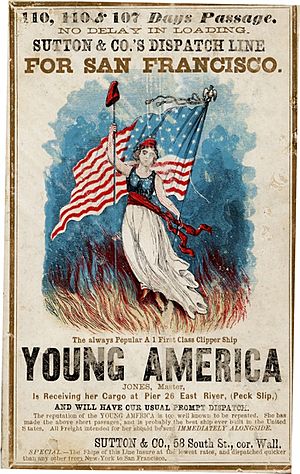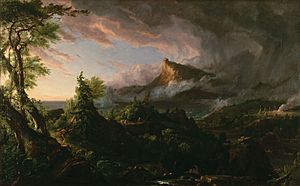Young America movement facts for kids
The Young America Movement was a group of Americans in the mid-1800s. They wanted to make big changes in politics, culture, and writing. This movement was inspired by similar groups in Europe from the 1830s.
In America, the group started as a political organization in 1845. It was founded by Edwin de Leon and George Henry Evans. They believed in free trade, which means trading goods without many taxes. They also wanted social reforms, which are improvements for society. The movement supported expanding the United States westward and southward. They also wanted to help democratic groups in other countries.
The Young America Movement also encouraged American writers. They wanted authors like Nathaniel Hawthorne, Herman Melville, and Walt Whitman to create truly "American" literature. In the 1850s, this movement became a part of the Democratic Party. Senator Stephen A. Douglas tried to use their ideas to unite the country, but it didn't work. When the movement broke up, many of its followers felt sad and disappointed.
John L. O'Sullivan explained the main goal of the Young America Movement. In 1837, he wrote in the Democratic Review magazine:
All history is to be re-written; political science and the whole scope of all moral truth have to be considered and illustrated in the light of the democratic principle. All old subjects of thought and all new questions arising, connected more or less directly with human existence, have to be taken up again and re-examined.
This means they wanted to look at all of history and ideas again. They wanted to see them through the lens of democratic principles.
Historian Edward L. Widmer says that O'Sullivan and his Democratic Review magazine were at the heart of the movement in New York City. So, the movement was mostly urban, meaning it was in cities. It was also made up of middle-class people. But it strongly focused on improving society for all Americans. This was especially true because many European immigrants, like Irish Catholics, were coming to New York in the 1840s.
Contents
Politics of Young America
Historian Yonatan Eyal says the 1840s and 1850s were the best years for this group of young Democrats. They called themselves "Young America." Leaders like Stephen A. Douglas, James K. Polk, Franklin Pierce, and financier August Belmont were part of it. This group moved away from older ideas about farming and strict rules. Instead, they supported business, new technology, and international relations.
Economic Ideas
When it came to money and business, Young America saw the need for modern transportation. They wanted railroads, canals, telegraphs, and better harbors. They supported the "Market Revolution," which was a time of big changes in how goods were made and sold. They also promoted capitalism, an economic system where private businesses own most things.
They asked Congress to give land to states. This allowed Democrats to say that improvements were local, not federal. Young America believed that modernizing the country would help farmers. It would let them sell their products and become successful. They linked these improvements to free trade. They also accepted some tariffs, which are taxes on imported goods, to help the government earn money. They supported the Independent Treasury, which was a government system for handling money. They saw it as a way to help all Americans become prosperous.
Decline of the Movement
The movement started to decline by 1856. This was because they couldn't successfully challenge older leaders. Also, Stephen Douglas failed to win the presidential nomination in 1852. They also struggled to deal with the issue of slavery. People in America also became less interested in reforms and more focused on their own country.
Manifest Destiny and Expansion
John L. O'Sullivan created the term "Manifest Destiny" in 1845. He wrote about it in the Democratic Review. He didn't necessarily mean that America should expand by force. He thought American democracy would spread on its own because it was so good.
The idea of "American exceptionalism," which means America is special, was later linked to "Manifest Destiny." But this was a changed idea in the 1850s. O'Sullivan even said that American democracy needed to grow to fight against the idea of aristocracy. Unlike Europe, America didn't have a system of nobles or kings for Young America to protest against.
Literature and Art
Besides promoting democracy in the Democratic Review, the Young America Movement also had a strong connection to literature. It attracted many great writers. These included William Cullen Bryant, George Bancroft, Herman Melville, and Nathaniel Hawthorne. They wanted American writing to be independent from European styles. They aimed to show how excellent and special America's own literary traditions were.
Other writers in the movement were Evert Augustus Duyckinck and Cornelius Mathews. It was Mathews who gave the movement its name. In a speech on June 30, 1845, he said:
Whatever that past generation of statesmen, law-givers and writers was capable of, we know. What they attained, what they failed to attain, we also know. Our duty and our destiny is another from theirs. Liking not at all its borrowed sound, we are yet (there is no better way to name it,) the Young America of the people: a new generation; and it is for us now to inquire, what we may have it in our power to accomplish, and on what objects the world may reasonably ask that we should fix our regards.
He meant that their generation had a new path and new goals.
One of the movement's main ways to share ideas was a literary magazine called Arcturus. Herman Melville even mentioned it in his book Mardi (1849). He named a ship Arcturion and said it was "exceedingly dull." The North American Review magazine said the Young America Movement was "at war with good taste."
Art and the Hudson River School
Beyond literature, there was also a clear art style linked to the Young America Movement. In the 1820s and 1830s, American artists like Asher Brown Durand and Thomas Cole became well-known. They were greatly influenced by romanticism, an art movement that focused on emotion and nature. This led to many paintings of natural landscapes.
Artist William Sidney Mount had connections to the writers of the Democratic Review. He was a contemporary of the Hudson River School, a group of landscape painters. Mount wanted to use art to promote American democratic ideas. E. A. Duyckinck, who worked with O'Sullivan at the Review, was very keen to start an art movement that would support Young America's goals.
Young America II
In late 1851, George Nicholas Sanders bought the Democratic Review magazine. Like O'Sullivan, Sanders believed that literature and politics should work together. He thought they could be used to help society progress. He even brought O'Sullivan back as an editor. However, the magazine's strong nationalism became even more intense than O'Sullivan's original ideas.
Democratic Representative John C. Breckinridge noticed this change in 1852. He said:
The Democratic Review has been heretofore not a partisan paper, but a periodical that was supposed to represent the whole Democratic Party ... I have observed recently a very great change.
The magazine's new tone was a reaction to the growing Free Soil movement. This movement threatened to divide the Democratic Party even more.
Rise of Labor Republicanism
By the mid-1850s, Democrats who opposed slavery and anti-slavery Whigs joined together. They formed the Republican Party. Young America Democrats in New York who were against slavery saw this as a chance to express their abolitionist views.
As a result, Horace Greeley's New York Tribune newspaper started to replace the Democratic Review. It became the main place for Young America's changing political ideas. In fact, Greeley's Tribune became a major supporter of not only ending slavery but also of land and labor reforms.
The idea of combining land and labor reform was best shown by George Henry Evans' National Reform Association (NRA). In 1846, Evans said:
National Reformers did not consider the Freedom of the Soil a panacea for every social and political wrong, but a necessary step in progress which would greatly facilitate all desirable reform, and without which no plan of reform could prevent the downward course of labor.
This meant they saw land reform as a key step to improving things for workers.
Eventually, former members of the radical Locofoco group in the Democratic Party saw a chance. They wanted to reorganize New York City's labor system around ideas like the common good. Unlike Europe during the 1848 revolutions, America didn't have an aristocratic system for Young America to protest against.




